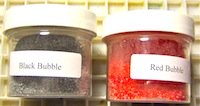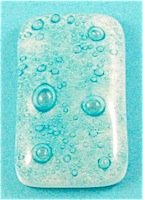Using Bubble Powder
In Glass Fusing
Bubble powder is used between glass sheets to make bubbles during the glass fusing process.
Available in a range of colors it is simply sprinkled or spooned in between fusing glass and then fused to create bubbles.
It comes in a fine and coarse grade; the fine grade will make larger bubbles than the coarser grade. The grades can be mixed together to produce varying design elements.
This material is compatible with float, Bullseye and Spectrum glasses.
The results can vary quite markedly; sometimes a large blister will form and may actually weaken the strength of the item if it is too near the surface. The reverse can occur and you will find many small bubbles and areas where no bubbles have formed.

Always wear a face mask and rubber gloves when handling this material.
Baking powders (sodium bicarbonate) or borax can also be used.
Copper oxide powder will also create bubbles. When used with clear glass it will become turquoise in color.

When thinned properly cerium oxide can be sprayed with a small spray gun evenly across the surface.
This process is normally carried out on large items such as bowls and dishes. Ordinary bubble powder is quite often used as a design features in large fused objects.
To apply to jewelry items, first sprinkle across a base glass then add clear cap and fuse in a fusing kiln.
Keep away from edges so that the clear cap can fuse to the base.
Results will vary depending on type and amount used as well as fusing temperature and duration of fusing schedule.
Finished pieces can be used in a number of jewelry items such as pendants, earrings and bracelets.
Bubble powder paint is now available, it can be applied as powder or mixed with a medium and then painted onto the surface. A wide range of colors is possible as a result of being able to mix the various colors.
Return From Papryos Fusing Paper To Art Glass Supplies
Return To Home Page



